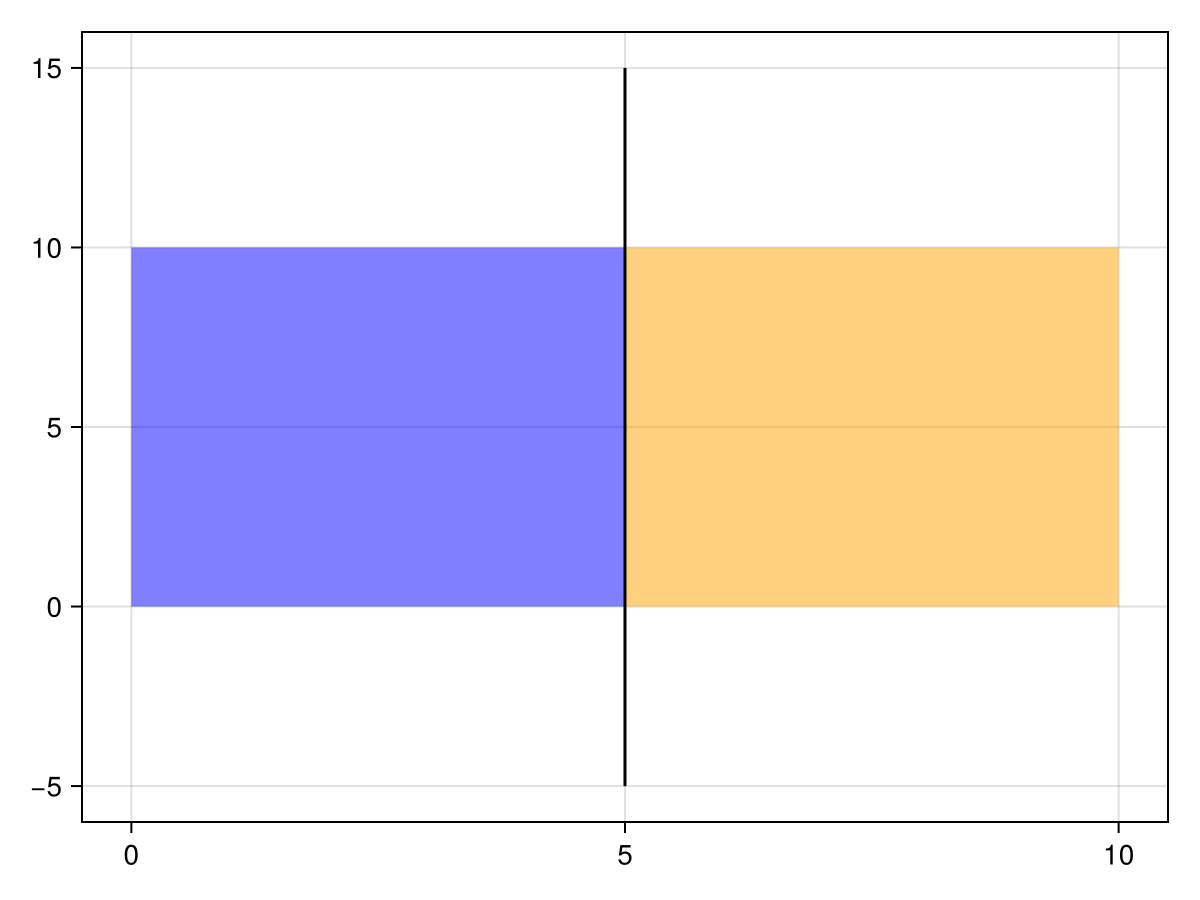Polygon cutting
export cutWhat is cut?
The cut function cuts a polygon through a line segment. This is inspired by functions such as Matlab's cutpolygon function.
To provide an example, consider the following polygon and line:
import GeoInterface as GI, GeometryOps as GO
using CairoMakie
using Makie
poly = GI.Polygon([[(0.0, 0.0), (10.0, 0.0), (10.0, 10.0), (0.0, 10.0), (0.0, 0.0)]])
line = GI.Line([(5.0, -5.0), (5.0, 15.0)])
cut_polys = GO.cut(poly, line)
f, a, p1 = Makie.poly(collect(GI.getpoint(cut_polys[1])); color = (:blue, 0.5))
Makie.poly!(collect(GI.getpoint(cut_polys[2])); color = (:orange, 0.5))
Makie.lines!(GI.getpoint(line); color = :black)
f
Implementation
This function depends on polygon clipping helper function and is inspired by the Greiner-Hormann clipping algorithm used elsewhere in this library. The inspiration came from this Stack Overflow discussion.
"""
cut(geom, line, [T::Type])
Return given geom cut by given line as a list of geometries of the same type as the input
geom. Return the original geometry as only list element if none are found. Line must cut
fully through given geometry or the original geometry will be returned.
Note: This currently doesn't work for degenerate cases there line crosses through vertices.
# Example
```jldoctest
import GeoInterface as GI, GeometryOps as GO
poly = GI.Polygon([[(0.0, 0.0), (10.0, 0.0), (10.0, 10.0), (0.0, 10.0), (0.0, 0.0)]])
line = GI.Line([(5.0, -5.0), (5.0, 15.0)])
cut_polys = GO.cut(poly, line)
GI.coordinates.(cut_polys)output
2-element Vector{Vector{Vector{Vector{Float64}}}}:
[[[0.0, 0.0], [5.0, 0.0], [5.0, 10.0], [0.0, 10.0], [0.0, 0.0]]]
[[[5.0, 0.0], [10.0, 0.0], [10.0, 10.0], [5.0, 10.0], [5.0, 0.0]]]
```
"""
cut(geom, line, ::Type{T} = Float64) where {T <: AbstractFloat} =
_cut(T, GI.trait(geom), geom, GI.trait(line), line; exact = _True())
#= Cut a given polygon by given line. Add polygon holes back into resulting pieces if there
are any holes. =#
function _cut(::Type{T}, ::GI.PolygonTrait, poly, ::GI.LineTrait, line; exact) where T
ext_poly = GI.getexterior(poly)
poly_list, intr_list = _build_a_list(T, ext_poly, line; exact)
n_intr_pts = length(intr_list)If an impossible number of intersection points, return original polygon
if n_intr_pts < 2 || isodd(n_intr_pts)
return [tuples(poly)]
endCut polygon by line
cut_coords = _cut(T, ext_poly, line, poly_list, intr_list, n_intr_pts; exact)Close coords and create polygons
for c in cut_coords
push!(c, c[1])
end
cut_polys = [GI.Polygon([c]) for c in cut_coords]Add original polygon holes back in
remove_idx = falses(length(cut_polys))
_add_holes_to_polys!(T, cut_polys, GI.gethole(poly), remove_idx; exact)
return cut_polys
endMany types aren't implemented
function _cut(::Type{T}, trait::GI.AbstractTrait, geom, line; kwargs...) where T
@assert(
false,
"Cutting of $trait isn't implemented yet.",
)
return nothing
end
#= Cutting algorithm inspired by Greiner and Hormann clipping algorithm. Returns coordinates
of cut geometry in Vector{Vector{Tuple}} format.
Note: degenerate cases where intersection points are vertices do not work right now. =#
function _cut(::Type{T}, geom, line, geom_list, intr_list, n_intr_pts; exact) where TSort and catagorize the intersection points
sort!(intr_list, by = x -> geom_list[x].fracs[2])
_flag_ent_exit!(GI.LineTrait(), line, geom_list; exact)Add first point to output list
return_coords = [[geom_list[1].point]]
cross_backs = [(T(Inf),T(Inf))]
poly_idx = 1
n_polys = 1Walk around original polygon to find split polygons
for (pt_idx, curr) in enumerate(geom_list)
if pt_idx > 1
push!(return_coords[poly_idx], curr.point)
end
if curr.interFind cross back point for current polygon
intr_idx = findfirst(x -> equals(curr.point, geom_list[x].point), intr_list)
cross_idx = intr_idx + (curr.ent_exit ? 1 : -1)
cross_idx = cross_idx < 1 ? n_intr_pts : cross_idx
cross_idx = cross_idx > n_intr_pts ? 1 : cross_idx
cross_backs[poly_idx] = geom_list[intr_list[cross_idx]].pointCheck if current point is a cross back point
next_poly_idx = findfirst(x -> equals(x, curr.point), cross_backs)
if isnothing(next_poly_idx)
push!(return_coords, [curr.point])
push!(cross_backs, curr.point)
n_polys += 1
poly_idx = n_polys
else
push!(return_coords[next_poly_idx], curr.point)
poly_idx = next_poly_idx
end
end
end
return return_coords
endThis page was generated using Literate.jl.